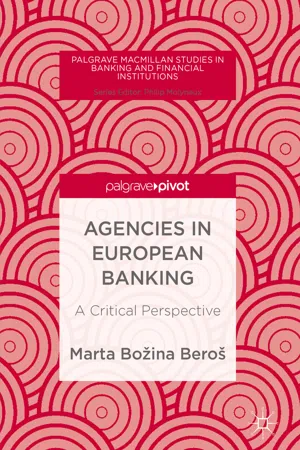This book examines agencies in the European banking sector—the European Banking Authority (EBA) and the Single Resolution Board (SRB)—by looking into the practical aspects of their internal governance structures and by focusing in particular on decision -making processes within their executive organs. Agencies have become a favoured instrument for deepening financial integration during the twin crises—the global financial and Eurozone crisis. As a result, salient powers in the policy creation process within the financial sector are being delegated to European agencies bearing different denominations (such as boards or authorities) and performing various tasks (for instance, knowledge-supportive role to EU institutions). The increased and further increasing reliance on agencies and their expertise1 (Everson 2012; Busuioc 2013a, b) is both a pragmatic by-product of substantive legislative reforms (Ferran 2017; Bajakić and Božina Beroš 2017) and a remedy to governance weaknesses disclosed by the twin crises (Weismann 2016, p. x). The development is particularly prominent in the field of banking prudential policy (regulation, supervision and resolution) since this policy field is an essential element of deepening financial integration. More than that in the banking sector, the crises have fully exposed the disruptive effects of the misalignment between the single (that is, European) monetary policy and distinct, national prudential policies on the sector’s systemic stability. It is not surprising then that prudential regulation and supervision have been at the core of crisis-driven reforms with the main objective to sever the “vicious circle” between banks and their sovereigns, who perceived them as national champions that are “too big to fail” and thus deserving of public funds being spent on their stabilization. Conceptually, the disassociation between banks and sovereigns is achieved through greater centralization of prudential policies (for example, by developing the Single Rulebook) and, in practice, through the creation of supranational authorities better suited to develop centralized policies and oversee their execution (Angeloni 2012).
The trend of agency governance was first embodied by the creation of three sectoral European Supervisory Authorities (ESAs) in 2010 (Bajakić and Božina Beroš 2017, p. 1746)—the EBA, the European Securities and Markets Authority (ESMA) and the European Insurance and Occupational Pensions Authority (EIOPA). In 2016 agency governance in the European banking sector was consolidated thanks to the establishment of the Banking Union (BU) and the SRB —a European agency as one of its key executive bodies (Božina Beroš 2017, p. 8) . The BU directly addresses Euro area countries, but it also envisages “close cooperation” arrangements with non-Euro area countries (through Memoranda of Understanding—MoUs). To date, no such agreement has been concluded. Thus, the BU created a permanent differentiation framework between EU members and where only a limited subset of countries is now moving faster to a closer Union (Ferran 2017). This fact is plainly illustrated by the fragmentation of the internal market for banking along the lines of “Euro area status” (Euro vs. non-Euro area countries, and BU “Ins” vs. “Outs”). This fragmentation makes governance of the European banking sector particularly challenging, as it requires sophisticated decision-making rules that will safeguard the functional equality2 of less integrated Member States (MS), as well as prevent BU “Outs” from taking a “free ride” on the BU “Ins” (Schimmelfenning 2016, p. 17).
Within the European banking sector, agencies have centralized substantive powers at the supranational level in prudential policy-making. At the same time, agencies have retained strong intergovernmental features in policy processes, by relying on a coordinated network of National Competent Authorities
(NCAs) (Bach et al.
2016, p. 9; Nieto
2015, p. 77). As a result, governance of the European banking sector has a hybrid
structure —one founded on a supranational, vertical hierarchy with strong horizontal, network-like characteristics (Groenleer et al.
2014, p. 2). This horizontality implies a dynamic interdependence among NCAs, whose distinct interests have to be confronted, reconciled and harmonized in interactive
decision-making processes (Maggetti
2014, p. 480). For the purpose of this book, agencies are understood as
specialized, non-majoritarian bodies, established by secondary legislation, which exercise public authority and are institutionally separate from the EU institutions and are endowed with legal personality. (Busuioc 2013b, p. 21)
As for “governance”, it is best described as modes of interaction between various actors in achieving common policy goals (Benz, Corcaci and Doser (2016)). Bringing the two concepts together, agency governance can broadly be defined as an effort to reshape heterogenous incentives of various stakeholders through “horizontal cross-fertilization among national administrations” (Dehousse 1997, p. 255; Rittberger and Wonka 2011) improve peer-to-peer learning in policy creation. From this perspective, agency governance is backed by an “expertocratic logic” (Eberlein and Grande 2005, p. 101) where policy creation centres on agencies’ scientific output and the “de facto coordination or even the harmonization of regulatory practices” (Ibidem, p. 105).
The argument of expertise introduces an additional reason in favour of agencies—that of de-politization of the policy creation process. Indeed, agencies perform their work “insulated from ongoing political processes” (Egeberg and Trondal 2009, p. 675) since they are “less sensitive to political steering and signals from above” (Egeberg and Trondal 2011, p. 871) because of their composition largely based on experts in specific policy areas coming from national authorities. Thus, agencies feed expert considerations rather than short-term political interests into policy creation processes (Ibidem, p. 676). In this respect, agencies are instrumental to the disassociation of banking prudential polic...
